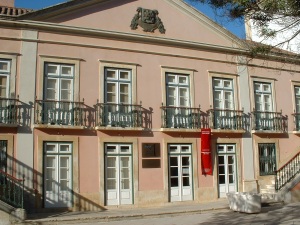
History
In the region of Caldas da Rainha human presence has long roots. Was inhabited by the Romans who left their marks and explored the existing sulfur waters until the barbarian invasions.
The previously known sources of Caldas de Óbidos were from the XIII century, attended by patients and lepers of “coldness” (arthritis) in these waters seeking the cure for their ills.
D. Leonor, wife of D. John II, and the landlord holds the lands of Óbidos since 1482, will make the institution in 1485, that would be the first Thermal Hospital in the world, and that would lead to a new town: the Caldas da Rainha.
During the sixteenth century, the hospital said establishment as a great institution and health care to the poor, being from the end of the seventeenth century, the target of several interventions by the various monarchs, including D. John IV, D. Peter III. And also with D. John V, since the eighteenth century ordered major reforms in the Hospital and the village.
The nineteenth century was a period marked, packed with major events in the history of Caldas Hospital. The visits of royalty become constant, triggering a movement of social renewal and revival around the spa. Attending the town of Caldas and the baths became a social fashion. More than the physical treatment, they will achieve the psychological well-being.
Today the heritage that has remained for over five centuries, and that accompanied the evolution of this institution, is under the administration of the Hospital of Oeste Norte, Ministry of Health
The building where it is installed and the Museum of the Hospital of Caldas, dating from the eighteenth century, it was appropriate for providers of home and officers of the Hospital. From the nineteenth century, is able to offer to host the directors and serve as accommodation for the royal family when traveling regularly to Caldas. Throughout the twentieth century, and performing various functions, was returned to the Hospital Center that made the recovery needed (1992) for installation of the Museu do Hospital e das Caldas.
Board off the lamb
Source: Hospital Termal
Dated: XVII
Panel of glazed tiles, painting blue and white. Attributed to Gabriel del Barco, from the Hospital de Nossa Senhora do Pópulo. Dating from 1667-1668. This administrative document in the left column represents the capacity of hospital (184 patients) and in the right columns, the algorithm of the multiplication of 3 / 4 of 1 arrátel ration of mutton for dinner for each patient.
Allowing. The panel, unusual for its creativity, is ornamented with festoons, elements shells, female figures standing on Aras captioned representing the charity and the work, and is visible at the top of the shield D. Pedro II.
“The Book of the Hospital Foundation”
XVII (1656)
Source: Hospital Termal
Role in binding with mutton.
Manuscript occupying 1,133 pages in folio, and is divided into six parts: 1. History of the Queen Leonor;. 2 History of the Foundation of the Hospital of Caldas, 3rd Hospital of Caldas at the time of the Restoration;. 4 History of Administration of the Hospital of Caldas Lóios;. 5 Goods and income of the Hospital of Caldas, 6. Memory and Antiquities of the Hospital of Caldas.
It is not known whether this was the title given by the author of George S. Paul, because in front where he can read is the century. XVIII. It is believed that the original title would be: “The origin, foundation and rules of the Hospital of Caldas”.
The canon of St. George Paul, of the Congregation of St. John Evangelista, was one of Lóios that administered the Hospital from 1532, been the provider of it. Developed a parallel activity, researcher, historian and writer, and was in this context that we left a great work on the Hospital of Caldas, where he would die, and buried in shallow grave in the Church of Nossa Senhora do Pópulo.
Book of Commitment
XVI
Manuscript on parchment, with illuminated capitals and letters painted by hand. Dated 18 March 1512, is a valuable document signed by Queen Leonor. Bound to sheep red cape with gold records and two metal buckles. It consists of a set of regulations aimed at the proper functioning hospital. The 16 leaves of the Book of Commitment are divided into 29 chapters, over which are mentioned in detail aspects of the administrative and religious life of the Hospital.
This regulation, which took as a model of an Italian hospital time (Hospital de Santa Maria in Siena or the Hospital of Santa Maria Nova, Florence) was as active participation D. Jorge da Costa, Cardinal Alpedrinha, confessor and adviser of Queen Leonor. The commitment of the Hospital of Caldas was in force until 1775, when the Marquis of Pombal replaced the part.
Fevereiro 5, 2017 at 1:05 pm
[…] en toegangsprijzen musea: Museu da Cerâmica Museu José Malhoa Museu do Hospital e das Caldas da Rainha Museu Barata Feyo Museu do […]
Março 26, 2017 at 5:12 pm
[…] Hospital Termal Adres: Rua Rodrigo Berquó, Caldas da Rainha Telefoon: (00 351) 262 830300 Website: Museu do Hospital Termal (let op: de informatie is volgens mij niet altijd up to date, zo staat er op de site een andere […]
Fevereiro 12, 2023 at 5:29 pm
[…] Caldas da Rainha Hospital Museum Art Collection […]
Fevereiro 17, 2023 at 8:03 pm
[…] Caldas da Rainha Hospital Museum Art Collection […]
Março 2, 2023 at 4:00 pm
[…] Caldas da Rainha Hospital Museum Art Collection […]